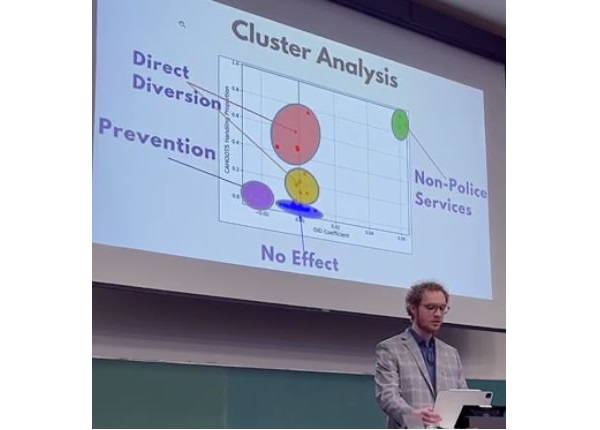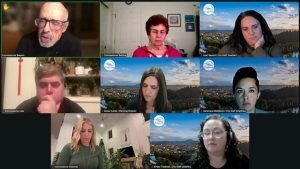UO researcher: CAHOOTS diverted 17% of all EPD calls
7 min read
Presenter: CAHOOTS is handling 17% of all calls to the Eugene Police Department, freeing up police officers to respond elsewhere. Research at the UO suggests that CAHOOTS can help EPD even more.
[00:00:12] Sharing her lab’s research April 10, the Hildegard Lamfrom Associate Professor of Data Science at the UO, Rori Rohlfs:
[00:00:21] Rori Rohlfs: Our first talk tonight describes research conducted in my lab. Nathan Burton will talk to us about his efforts to estimate CAHOOTS diversion rates.
[00:00:31] Nathan is a recent graduate of the University of Oregon program in data science. He has been conducting research on CAHOOTS since he graduated last spring, and previously he served six years in the National Guard.
[00:00:43] Presenter: Nathan Burton:
[00:00:44] Nathan Burton: So one way to measure the impact of CAHOOTS is when CAHOOTS redirects a call that otherwise would’ve gone to the police. This is useful because it helps us understand how many more calls the police would need to handle if CAHOOTS didn’t exist.
[00:00:58] At first glance, if CAHOOTS is taking on calls that would otherwise go to the police, we can just compare the two, and that’s our diversion, right? Unfortunately, it’s not that simple because CAHOOTS calls involve work that police would not normally do.
[00:01:10] Take emergency transportation, for example. That’s not a typical police service, but it is a big part of what CAHOOTS does. So here’s the key question: How many of those CAHOOTS calls actually are nonpolice services?
[00:01:22] Unfortunately, there’s no simple label in our data that can tell us. There’s no box that says, ‘Not a police call,’ so we have to be a little bit creative.
[00:01:29] Fortunately, there was a key event all the way back in 2017 that allows us to conduct an experiment. In 2017, CAHOOTS expanded their services to include the hours of 3 a.m. to 7 a.m. Before that change, police were handling 100% of the calls during those hours, which means that all of those calls were police responsibilities.
[00:01:48] So here’s the idea: For call types where CAHOOTS was just taking over for the police, the number of calls should not increase that much. The calls are just shifting hands, so you shouldn’t see that big of an increase.
[00:01:58] However, call types that do see significant increases likely involve some number of nonpolice services, and we can use that increase to estimate how many nonpolice services are being added to each call type.
[00:02:09] So which call types saw these meaningful increases after the expansion? Well, we found three: ‘transportation,’ ‘public assist,’ and ‘found syringe.’ Each of these all saw statistically significant jumps, and each is predominantly handled by CAHOOTS. That tells us something important. These call types are likely new services outside of traditional police work.
[00:02:29] So using these increases as an estimation of how many CAHOOTS calls are nonpolice services, we find a diversion rate of around 17%.
[00:02:37] Presenter: Nathan emphasized that each call represents a human being during a moment of need. Nathan Burton:
[00:02:43] Nathan Burton: Now, I want to pause for a second because it’s easy to lose sight of the human impact when we’re talking about percentages and call types and numbers. But every single one of those 10,000 calls is a real person and a real moment of need where CAHOOTS was there to help. And because CAHOOTS was there to help, it meant that police officers had more time to focus on other calls. It meant people in crisis were met by trained mental health professionals, and our community was made that much safer.
[00:03:09] 17% might seem abstract at first, but it represents 10,000 real people that CAHOOTS helped.
[00:03:16] Now CAHOOTS, stepping in for police is a key part of how diversion works, but it’s actually not the whole story.
[00:03:23] Several call types also saw significant decreases following the service hour expansion. Calls like ‘suspicious subject dispute,’ ‘surly subject,’ ‘theft,’ even DUIs, all saw significant decreases. In addition to directly diverting calls from the EPD, CAHOOTS seems to play another role: preventing calls from ever happening in the first place.
[00:03:42] So CAHOOTS often responds to situations that don’t quite rise to the level of a police call, but if ignored, that call could very easily escalate. Take a nonemergency transportation, for example. At first glance, this might seem completely unrelated to police work, but imagine that ride was for someone struggling with their mental health.
[00:03:59] Without that support, they could end up disoriented in a dangerous place or even become combative with the public, and then suddenly that’s a police call. While it’s not a direct diversion, it’s essentially a future diversion since it removes a future call that police otherwise would’ve needed to deal with.
[00:04:13] So how can we know if CAHOOTS is actually preventing certain kinds of police calls? Well, clustering analysis revealed several important categories. We found this prevention effect in the following call types: ‘Disorderly subject,’ ‘suspicious subject’ and ‘dispute.’
[00:04:27] And that’s important because these are exactly the kinds of situations you would expect to arise from unmet social needs, mental health struggles, substance use, chronic instability. Without services like CAHOOTS, people dealing with those challenges are far more likely to end up in conflict with the public or with the police.
[00:04:43] So while CAHOOTS certainly provide services that are outside of traditional policing, these services can still have very real impacts on everyday police work.
[00:04:52] Now, we’ve already discussed and shown that CAHOOTS is making a major difference. They handle 17% of all of the calls that would otherwise go to the police department. That’s impressive. But it raises another important question: Could CAHOOTS be diverting even more calls?
[00:05:08] And that’s not just a theoretical question. It matters because the answer helps us understand the true potential of expanding the program.
[00:05:14] To answer this question, we look at call types that both police and CAHOOTS regularly respond to. After running our analysis, we identified several call types; let’s focus on the two largest: welfare checks and suicidal subjects. These are the most common shared responsibilities between CAHOOTS and the police. And as you can see, CAHOOTS is already handling half of these.
[00:05:34] That’s a major accomplishment, but it tells us that there’s also more room for CAHOOTS to expand. We would likely see significant reductions in workload for the rest of our emergency response system were we to expand CAHOOTS.
[00:05:47] Presenter: He noted that the county’s Mobile Crisis Response team doesn’t conduct welfare checks. Nathan Burton:
[00:05:53] Nathan Burton: Now, some of you may have heard that Lane County is rolling out a new mobile crisis response team that might sound like it’s a replacement for CAHOOTS, but it’s important to understand that it’s not a one-to-one substitute.
[00:06:03] And here’s one key difference that you can see right now. Welfare checks are the single largest source of diversions in our entire system, and the Lane County model doesn’t respond to these. Without CAHOOTS, all of these welfare checks will go directly to the police and will not be diverted at all.
[00:06:20] These situations involve some of the most complex and sensitive situations that our community faces and their response really matters, and this is one of the reasons why we cannot lose CAHOOTS.
[00:06:29] When we look across all of the calls that either CAHOOTS or the police could theoretically respond to, we find that CAHOOTS handles nearly half of all of them every single year.
[00:06:39] They divert around 17% of all dispatch calls every year, and our research also shows that CAHOOTS is still only diverting about half of what they could be, given sufficient support.
[00:06:49] On top of that, CAHOOTS isn’t just responding to crises. They’re actually preventing them from ever happening in the first place. CAHOOTS is effective, it’s lifesaving, it’s smart policy, and it’s a program that we should be expanding, not losing.
[00:07:00] Some may ask (and they may rightly ask this): How are we going to afford CAHOOTS? But I think the better question is: How can we afford to go without CAHOOTS?
[00:07:08] How can our community afford more stress on our police, our firefighters, and our medics? How can we afford to reduce services for the homeless or for those on the verge of suicide? I don’t think we can, and I don’t think you do either. And that’s why I’m so thankful for y’all being here today, to support CAHOOTS and to find out how we can save this amazing service.
[00:07:27] Presenter: Later during the CAHOOTS town hall, he was asked about his data set. Nathan Burton:
[00:07:33] Nathan Burton: So basically our data comes from the CAD system. So every time a police call or a CAHOOTS call happens, it goes through Dispatch, so it spawns a new call in the CAD system. So we basically got that data through a public records request.
[00:07:46] So we got all that raw data, we did some data cleaning. And then so for the service hour expansion experiment, we did only compare 2016 and 2017 because that’s the data we had. But we are actually working on getting more data so we can hopefully, get even more robust results and find out even more about that.
[00:08:01] So just stay tuned and we’ll keep looking at it. Thank you.
[00:08:08] Presenter: UO research shows that CAHOOTS is saving the city money by diverting 17% of all EPD calls, and could save the city even more.
This story produced by John Q and sponsored through the Whole Community Time Bank by generous listeners at KEPW 97.3, Eugene’s PeaceWorks Community Radio.



